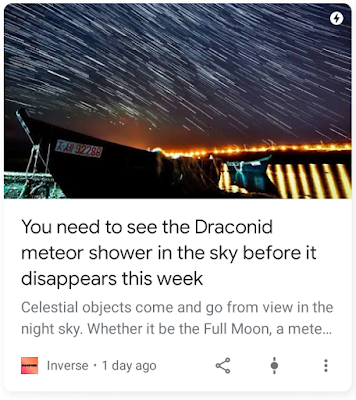You should also know that the Draconids are a weaker shower. At peak, they produce, on average, 50 sightings per hour at the zenith (ZHR). Perseids, the summer favourite, produce 70 ZHR at peak while the Geminids in December can make 120. Of course, meteor showers have a random component, so it could be more, it could be less. You's takes your chances. And you must be patient.
And if one can successfully avoid wasteful human-made light pollution, then there's natural. The Moon is at Third Quarter phase, rising at 10:00 PM. We usually tell people meteors are best seen after midnight. Well, guess what? The bright Moon will be well up by then and rising higher and higher to dawn. So good luck seeing anything!
Who is Inverse? Clearly they don't know what they're talking about.
Remember, consult the experts. Visit the American Meteor Society or the International Meteor Organisation for the correct and current information, the facts.
§
Update from IMO: There was a purported outburst with more than 100 ZHR. That's cool but the meteors "were mostly faint (+4 to +5 magnitudes), with few bright meteors." So, most would not be visible in bright urban skies.
§
By the way, the banner photo is by Yuri Smityuk via Getty Images.



No comments:
Post a Comment